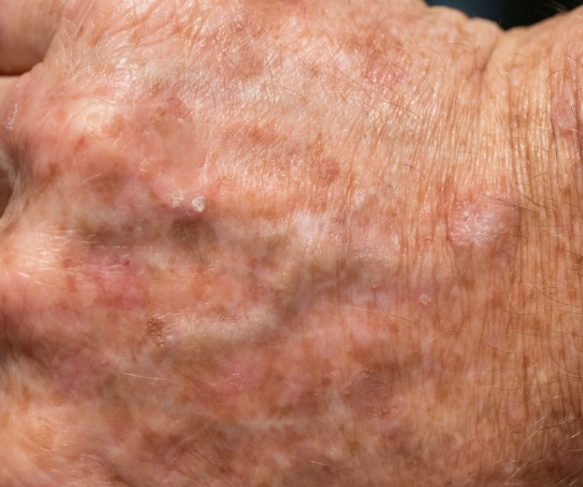Actinic Keratosis Treatment in Brisbane
Safe, effective, medically-led care for sun-damaged and precancerous skin
If you’ve noticed rough, dry, scaly, or thickened patches on your skin, these may be actinic keratoses. They can appear warty, crusty, or discoloured and are often found on areas frequently exposed to the sun. While they may seem minor at first, it’s important to take them seriously and seek professional assessment as soon as possible. If left untreated, actinic keratoses can develop into skin cancers. Early diagnosis allows your doctor to determine the best approach, monitor changes, and reduce any potential risks.
At Queensland Skin and Laser, we understand how worrying it can feel to spot changes in your skin. Our team provides medically-led, safe, and effective treatments tailored to your individual needs. Whether you have a single lesion or multiple areas of sun-damaged skin, there are a range of options available, from cryotherapy and topical treatments to advanced light and laser therapies. By seeking care early, you can manage actinic keratosis effectively and protect your skin’s long-term health.
What Is Actinic Keratosis?
Actinic keratoses are precancerous skin lesions that develop on areas of skin frequently exposed to the sun. They often appear as rough, dry, or scaly patches and are most common on the face, scalp, ears, hands, and forearms. While usually harmless, some actinic keratoses can progress into squamous cell carcinoma (a type of skin cancer) if left untreated.
Most actinic keratoses can be successfully treated. However, they can recur, and new lesions may develop over time due to previous sun exposure. Regular follow-up appointments are important to monitor your skin and address new concerns early.
What Causes Actinic Keratosis?
The main cause of actinic keratosis is ultraviolet (UV) radiation from the sun. UV exposure damages the DNA of skin cells, leading to abnormal cell growth. Over time, repeated exposure impairs the skin’s ability to repair itself, resulting in visible sun damage, rough texture, and the formation of actinic keratosis.
At Queensland Skin and Laser, we offer bulk-billed skin checks to support early detection and proactive care for your skin.
How is Actinic Keratosis Diagnosed at
Queensland Skin and Laser?
WHY EARLY ASSESSMENT IS IMPORTANT
Diagnosis
Actinic keratoses are typically diagnosed based on their appearance during a clinical skin examination, often using a dermatoscope to help distinguish them from other lesions. In some cases, a biopsy may be performed to confirm the diagnosis or rule out skin cancer.
Complications and Risks
The main concern with actinic keratosis is their potential to develop into cutaneous squamous cell carcinoma (SCC). For patients with more than 10 actinic keratoses, the risk of developing SCC at some stage is around 10–15%. A lesion that is tender, thickened, ulcerated, or enlarging is more suspicious for progression to SCC and should be evaluated promptly. Because these lesions occur on sun-damaged skin, people with actinic keratoses are also at increased risk of developing basal cell carcinoma (BCC), or melanoma.
Who Gets Actinic Keratosis?
Actinic keratosis lesions are a sign of cumulative sun damage, often developed over many years. They are most common in people who have:
- Fair skin that burns easily
- Lived or worked in sunny climates such as Queensland
- Spent long hours outdoors for work or recreation
- Visible signs of sun damage or photoaged skin
- A weakened immune system
Know your risk factors for sun-damaged skin.
WhAT DOES Actinic Keratosis Look Like?
The appearance of actinic keratoses can vary. They may be:
- Flat, rough or thickened patches
- White, yellow, red, or skin-coloured
- Scaly, crusty, or warty to touch
- Sometimes tender or sensitive, though often painless
They often occur in clusters on areas that receive frequent sun exposure, such as the scalp, temples, cheeks, nose, and backs of the hands.
Treatment options for Actinic Keratosis
AT QUEENSLAND SKIN AND LASER
Safe and effective treatments for sun-damaged skin.
Treatment aims to remove or reduce precancerous cells, restore healthier skin, and prevent further damage. The approach depends on the number, location, and severity of the lesions.
- Cryotherapy: Liquid nitrogen is used to freeze and remove individual lesions. Ideal for treating a few spots.
- Topical Treatments: Prescription creams containing active ingredients (e.g., salicylic acid) help shed damaged cells over several weeks.
- Medical-grade skincare: Glycolic and lactic acids in washes, toners, and overnight creams can take several months to show results, but also help improve fine lines, pigmentation, and enlarged pores.
- Chemical Peels: Stronger acid-based peels exfoliate the top layer of sun-damaged skin, encouraging new, smoother skin to form.
- Photodynamic Therapy (PDT): A light-sensitive cream is applied, then activated by a special light to target abnormal cells selectively. Often used for multiple AKs.
- Intense Pulsed Light (IPL): Targets redness, pigment, and mild sun damage, helping improve overall skin tone.
- 1540nm Non-Ablative Laser: Fractional laser technology that resurfaces and regenerates sun-damaged skin.
- RF Microneedling: Stimulates collagen remodelling and skin renewal, improving texture and resilience.
Treatment selection is always individualised based on your skin type, medical history, and goals.
Actinic Keratosis Treatment Process At Queensland Skin And Laser
What to Expect During Your Treatment
Consultation
Your journey begins with a comprehensive skin assessment. During your consultation, your doctor will examine the spots, determine whether they may be actinic keratoses, and discuss your treatment options based on the number, size, and location of lesions. This is also the time to address any concerns and plan a strategy tailored to your skin.
Preparation
Before treatment, you may be advised to avoid sun exposure, certain skincare products, or medications that could increase sensitivity. Your doctor will provide specific instructions to ensure your skin is ready for the chosen procedure and to maximise treatment effectiveness.
Treatment
Treatment for actinic keratoses is personalised based on your skin type and the characteristics of your lesions. Options can include freezing individual spots (cryotherapy), topical medical-grade creams, chemical peels, photodynamic therapy (PDT), and laser or light-based treatments such as IPL, fractional laser, or RF microneedling.
Aftercare
Following treatment, your skin may be red, tender, or slightly flaky for a few days. Your doctor will provide instructions on gentle cleansing, moisturising, and sun protection. Avoid picking at treated areas and follow up as recommended to ensure proper healing.
Results
Most actinic keratoses respond well to treatment, with improved skin texture and reduced lesions. Regular follow-up appointments help monitor for new or recurring spots and ensure ongoing protection against sun-related damage. Consistent sun protection and skin checks are key to maintaining results long-term.
PREVENTION OF ACTINIC KERATOSIS
Prevention focuses on sun protection and early detection. To help prevent new actinic keratoses and protect your skin:
- Have regular skin checks to monitor for changes
- Apply a broad-spectrum SPF 50+ sunscreen daily
- Wear sun-protective clothing, a wide-brimmed hat, and sunglasses
- Consider including nicotinamide (vitamin B3) in your daily routine as studies suggest it may reduce the recurrence of actinic keratosis
Protect your skin from further sun damage
Why Choose Us for
Actinic Keratosis Treatment?
At Queensland Skin and Laser, our medically-led team provides personalised care and evidence-based treatments for actinic keratoses and other skin concerns. We combine expertise, advanced technology, and a patient-focused approach to ensure your skin is assessed, treated, and monitored safely and effectively.
Expert-Led
Care
Led by Dr. Mark Chernoff, a seasoned physician with expertise in skin cancer detection, general and cosmetic dermatology, and advanced laser therapies, the clinic ensures high standards of care across all treatments.
Advanced
Technology
Queensland Skin and Laser integrates state-of-the-art laser systems, HIFU, RF needling, and photodynamic therapy, offering the latest in skin rejuvenation, tightening, and sun damage treatment.
Patient-Centred,
Boutique Experience
Patients experience a personalised, boutique environment where their concerns are met with unmatched professionalism and dedicated care.
Complimentary Cosmetic
Consultations
Clients receive a free consultation with the clinic’s cosmetic nurses, making expert skin advice accessible without upfront costs.
Flexible Payment
Plans
Offering weekly payment options through Zip Pay, the clinic ensures financial flexibility for both cosmetic and medical treatments.
Trusted Reputation
and Certifications
As a Fellow of the RACGP, an accreditation assessor, and an experienced dermatology professional, Dr. Chernoff and his team are recognised for their commitment to high standards, safety, and patient well-being.
Meet Dr Mark Chernoff
BSC (EXHP), MBBS (MELB), FRACGP, MFIN, CFTP
Dr Mark Chernoff earned a Bachelor of Science in Exercise and Health Physiology, followed by a Bachelor of Medicine and Bachelor of Surgery from the University of Melbourne in 2010. He began his postgraduate career at St. Vincent’s Hospital in Melbourne, specialising in general and plastic surgery.
Dr Chernoff serves as a Visiting Medical Officer in Emergency Medicine and works as a general practitioner in rural NSW. With extensive experience in skin cancer surgery, medical laser treatments and cosmetic medicine, he also contributes to medical education by supervising registrars for the Australian College of Rural and Remote Medicine and the Royal Australian College of General Practitioners.
To book an appointment, click the button above, call 07 3544 6425, or email admin@qldskinandlaser.com.
Find us here:
- Level 2 – 445 Upper Edward St
Spring Hill QLD 4000
Frequently Asked Questions About
Actinic Keratosis Treatment
Where do actinic keratosis usually appear?
Actinic keratoses commonly develop on sun-exposed areas of the body, including the face, ears, scalp, backs of hands, forearms, and shoulders. These regions receive the most ultraviolet (UV) radiation over time, which increases the risk of abnormal skin changes. Regular skin checks in these areas can help detect actinic keratosis early. Therefore, book a free skin check at Queensland Skin and Laser to minimalise your skin cancer risk.
What are the early signs of an actinic keratosis?
Early actinic keratosis often appear as small, rough, dry, or scaly patches of skin. They may also be slightly raised, crusty, or discoloured, appearing pink, red, brown, or yellow. Some lesions can be tender, but many are painless. Any persistent rough patch that does not heal should be assessed by a doctor.
Can actinic keratosis be prevented?
Yes, actinic keratosis can often be prevented through consistent sun protection and early monitoring. Applying broad-spectrum sunscreen with SPF 50+, wearing sun-protective clothing, hats, and sunglasses, and avoiding prolonged sun exposure during peak hours can significantly reduce the risk. Regular skin checks with a doctor also help detect early changes and prevent new lesions.
Can an actinic keratosis turn into skin cancer?
Actinic keratoses are considered precancerous lesions, meaning they may develop into squamous cell carcinoma (SCC) if left untreated. For individuals with more than ten actinic keratosis, the lifetime risk of SCC is around 10–15%. actinic keratosis also indicate broader sun damage and an increased risk of basal cell carcinoma (BCC) and melanoma. Because the risk of progression is unpredictable, early assessment by a doctor is important.
How is an actinic keratosis diagnosed and when should I see a doctor?
A doctor usually diagnoses actinic keratosis through a clinical skin examination. In some cases, a biopsy may be required to confirm the lesion type and rule out skin cancer. You should see a doctor if you notice new or changing rough patches, or if a lesion becomes tender, thickened, ulcerated, or rapidly enlarging. Early consultation allows your doctor to evaluate your skin, recommend appropriate treatment, and monitor any changes.
What treatment options exist and how can I prevent more actinic keratosis?
Treatment for actinic keratosis depends on the number, size, and location of lesions. Options include freezing individual lesions, topical medical-grade creams, chemical peels, photodynamic therapy, and laser or light-based treatments. Preventing new actinic keratosis remains important, which involves daily sun protection, wearing protective clothing, and regular skin checks. To discuss the most suitable treatment for your skin, contact our clinic to arrange a consultation.
Any surgical or invasive procedure carries risks. Before proceeding, you should seek a second opinion from an appropriately qualified health practitioner.
Have any questions about Actinic Keratosis Treatment in Brisbane? Complete the form below and we will get back to you shortly.




